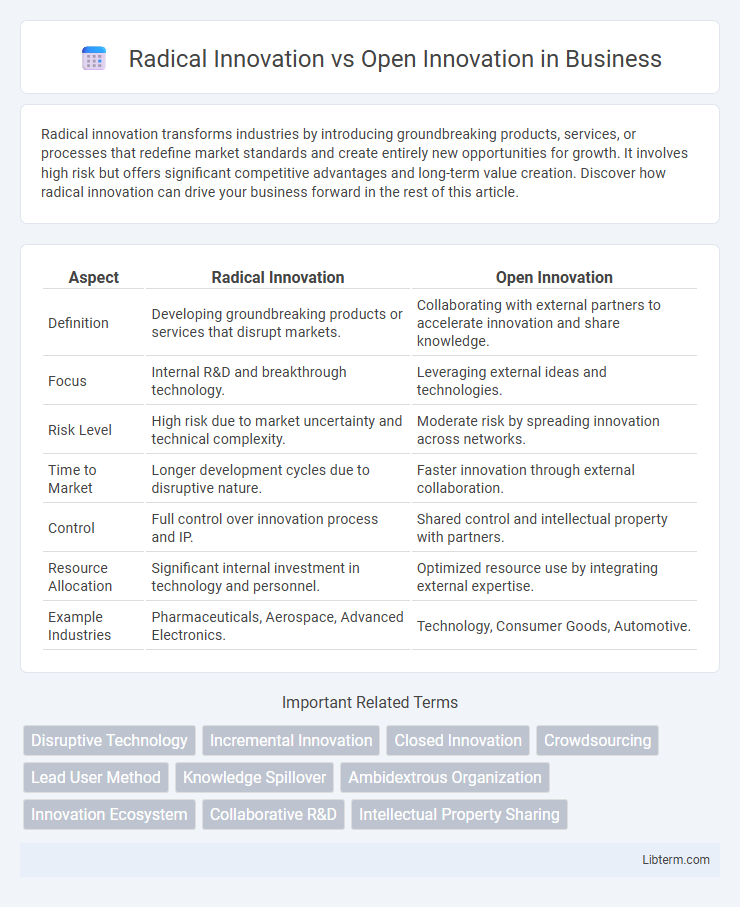Radical innovation transforms industries by introducing groundbreaking products, services, or processes that redefine market standards and create entirely new opportunities for growth. It involves high risk but offers significant competitive advantages and long-term value creation. Discover how radical innovation can drive your business forward in the rest of this article.
Table of Comparison
| Aspect | Radical Innovation | Open Innovation |
|---|---|---|
| Definition | Developing groundbreaking products or services that disrupt markets. | Collaborating with external partners to accelerate innovation and share knowledge. |
| Focus | Internal R&D and breakthrough technology. | Leveraging external ideas and technologies. |
| Risk Level | High risk due to market uncertainty and technical complexity. | Moderate risk by spreading innovation across networks. |
| Time to Market | Longer development cycles due to disruptive nature. | Faster innovation through external collaboration. |
| Control | Full control over innovation process and IP. | Shared control and intellectual property with partners. |
| Resource Allocation | Significant internal investment in technology and personnel. | Optimized resource use by integrating external expertise. |
| Example Industries | Pharmaceuticals, Aerospace, Advanced Electronics. | Technology, Consumer Goods, Automotive. |
Understanding Radical Innovation: Definition and Characteristics
Radical innovation refers to breakthrough advancements that fundamentally change industries by introducing entirely new products, services, or processes with transformative impact. It is characterized by high uncertainty, significant technological shifts, and the creation of unprecedented value, often disrupting existing markets. Understanding radical innovation involves recognizing its potential to redefine competitive landscapes and drive long-term growth through pioneering ideas that differ markedly from incremental improvements.
What is Open Innovation? Key Principles Explained
Open Innovation is a business management model that emphasizes collaboration with external partners to accelerate internal innovation and expand markets for external use of innovation. Key principles include leveraging external and internal ideas, sharing risks and rewards, and integrating inbound and outbound knowledge flows. This model contrasts with Radical Innovation, which typically relies on breakthrough internal developments without extensive external collaboration.
Radical Innovation vs Open Innovation: Core Differences
Radical innovation involves breakthrough ideas that create entirely new markets or disrupt existing ones, while open innovation leverages external ideas and collaborations to enhance internal innovation processes. The core difference lies in radical innovation focusing on transformative change driven internally, whereas open innovation emphasizes external knowledge integration and co-creation. Radical innovation demands risk-taking and significant resource investment, contrasting with open innovation's strategic partnerships and shared risk approach.
Advantages and Challenges of Radical Innovation
Radical innovation offers significant advantages such as creating entirely new markets, establishing strong competitive advantages, and driving substantial technological breakthroughs that can lead to long-term growth and industry transformation. However, its challenges include high uncertainty and risk, substantial resource investment, and the difficulty of predicting market acceptance and integration with existing systems. Companies pursuing radical innovation must balance visionary ideas with strategic risk management to successfully bring groundbreaking products or services to market.
Benefits and Risks of Open Innovation
Open Innovation fosters collaboration between internal teams and external partners, accelerating product development and expanding market reach. Benefits include access to diverse expertise, shared risks, and reduced R&D costs, enhancing overall innovation efficiency. Risks involve potential intellectual property leakage, loss of competitive advantage, and challenges in aligning strategic goals between collaborators.
When to Choose Radical Innovation Over Open Innovation
Radical innovation is ideal when breakthrough technologies or disruptive business models can significantly alter market dynamics and create new value propositions. Choosing radical innovation over open innovation is crucial in high-stakes environments where proprietary knowledge and competitive advantage depend on unique, internally developed solutions. Firms should prioritize radical innovation when speed, secrecy, and control over intellectual property are essential to outperform incumbents and capture market leadership.
Case Studies: Companies Leveraging Radical Innovation
Tesla's radical innovation in electric vehicles revolutionized the automotive industry by introducing high-performance, long-range EVs, setting new standards for sustainability and technology integration. SpaceX disrupted aerospace through radical innovation by developing reusable rockets, drastically reducing launch costs and enabling ambitious space missions. Beyond these, companies like Dyson have leveraged radical innovation in vacuum technology, combining powerful suction with novel cyclone technology to dominate their market segment.
Case Studies: Success Stories in Open Innovation
Case studies of open innovation reveal companies like Procter & Gamble leveraging external collaborations to accelerate product development and achieve market breakthroughs, contrasting with radical innovation's internally driven, transformative changes exemplified by Tesla's electric vehicles. Unilever's open innovation platform, Connect & Develop, has successfully integrated consumer-driven insights and startup technologies, resulting in faster time-to-market and enhanced product relevance. These success stories highlight open innovation's ability to harness diverse expertise and resources beyond traditional R&D boundaries for sustained competitive advantage.
Integrating Radical and Open Innovation for Maximum Impact
Integrating radical innovation and open innovation accelerates breakthrough technologies by combining bold, transformative ideas with collaborative external expertise and resources. Organizations leveraging open innovation networks can identify and scale radical innovations more efficiently, reducing time-to-market and sharing risks. Strategic alignment of these approaches fosters a dynamic ecosystem where disruptive solutions are co-created, enhancing competitive advantage and driving sustainable growth.
Future Trends Shaping Radical and Open Innovation
Future trends shaping radical and open innovation emphasize the integration of advanced AI technologies and collaborative digital platforms, accelerating breakthrough solutions and democratizing innovation processes. The rise of decentralized innovation ecosystems leverages blockchain and crowdsourcing to enhance transparency and efficiency, enabling radical ideas to emerge from diverse global contributors. Sustainable innovation and social impact priorities increasingly influence both radical and open innovation frameworks, driving businesses to align cutting-edge developments with environmental and societal goals.
Radical Innovation Infographic

 libterm.com
libterm.com